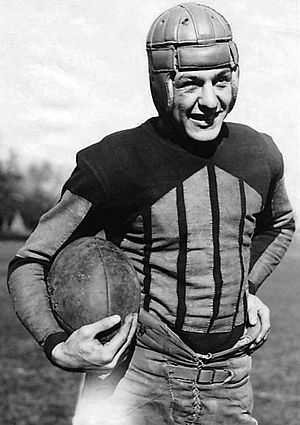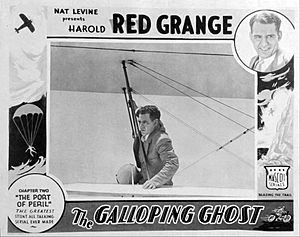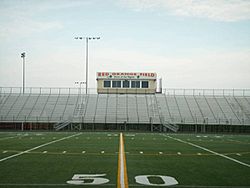Red Grange facts for kids
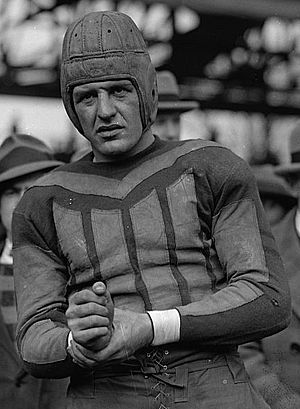
Grange in 1925
|
|||||||||||||||
| No. 77 | |||||||||||||||
|---|---|---|---|---|---|---|---|---|---|---|---|---|---|---|---|
| Position: | Halfback | ||||||||||||||
| Personal information | |||||||||||||||
| Born: | June 13, 1903 Forksville, Pennsylvania, U.S. |
||||||||||||||
| Died: | January 28, 1991 (aged 87) Lake Wales, Florida, U.S. |
||||||||||||||
| Height: | 6 ft 0 in (1.83 m) | ||||||||||||||
| Weight: | 180 lb (82 kg) | ||||||||||||||
| Career information | |||||||||||||||
| High school: | Wheaton (Wheaton, Illinois) | ||||||||||||||
| College: | Illinois (1923–1925) | ||||||||||||||
| Career history | |||||||||||||||
| As player: | |||||||||||||||
|
|||||||||||||||
| As coach: | |||||||||||||||
|
|||||||||||||||
| As executive: | |||||||||||||||
|
|||||||||||||||
| Career highlights and awards | |||||||||||||||
|
|||||||||||||||
| Career NFL statistics | |||||||||||||||
|
|||||||||||||||
| Player stats at PFR | |||||||||||||||
|
Pro Football Hall of Fame
|
|||||||||||||||
|
College Football Hall of Fame
|
|||||||||||||||
Harold "Red" Grange (born June 13, 1903 – died January 28, 1991) was an amazing American football player. People called him "the Galloping Ghost" and "the Wheaton Iceman." He played as a halfback for the Chicago Bears and the New York Yankees. When he joined the Bears, it made the National Football League (NFL) much more popular.
Red Grange played college football for the Illinois Fighting Illini. He was chosen as an All-American three times. In 1923, he led his team to win a national championship. In 1924, he won the Chicago Tribune Silver Football award. This award was for the best player in the Big Ten Conference. Later, ESPN named Grange the best college football player ever in 2008. In 2011, the Big Ten Network called him the Greatest Big Ten Icon.
After his last college game in 1925, Grange joined the Bears. He went on a special tour across the country. This tour helped make the NFL famous. When his first contract ended, he and his agent, C. C. Pyle, started a new league in 1926. It was called the American Football League. Grange played for the Yankees in this league. The league only lasted one year. Then, the Yankees team joined the NFL.
In 1927, Grange hurt his knee badly. He could not play the next season. He came back to the Bears in 1929. He played for them until 1934, when he stopped playing. After that, he became a coach for the Bears for three seasons. Red Grange is a founding member of both the College and Pro Football Halls of Fame.
Contents
Early Life and High School Football
Red Grange was born on June 13, 1903. He grew up in Forksville, Pennsylvania, a small village. His father, Lyle, managed three lumber camps. Red's mother passed away when he was only five years old. For a few years, his family lived with relatives. Later, they moved to Wheaton, Illinois, and bought their own home. In Wheaton, his father became the chief of police.
At Wheaton High School, Grange was a star athlete. He earned 16 varsity letters in football, baseball, basketball, and track. In football, he scored 75 touchdowns and 532 points. As a junior, he scored 36 touchdowns. He led his high school team to a perfect season. In his senior year, his team won almost every game.
Grange was also a great track and field runner. In 1920, he won the state high jump title. He also placed well in the 100-yard and 220-yard dashes. In 1921, he won state titles in the long jump and 100-yard dash. He was very fast, running the 100-yard dash in 9.8 seconds. This was almost as fast as the world record at the time.
To help his family, Red worked part-time. He carried ice for $37.50 a week. This job helped him build strong muscles. It also gave him his famous nicknames: "Ice Man" and "the Wheaton Ice Man."
College Football at Illinois
After high school, Grange went to the University of Illinois. He first planned to play only basketball and track. But he changed his mind and joined coach Bob Zuppke's Fighting Illini football team. Grange also worked as a model for a local clothing store.
Grange played for the Illini from 1923 to 1925. In his very first college game, he scored three touchdowns against Nebraska. As a sophomore, he ran for 723 yards and scored 12 touchdowns. He led Illinois to a perfect season and a national championship in 1923.
He became famous nationwide for his game against Michigan on October 18, 1924. This game was the grand opening of the new Memorial Stadium. Michigan was favored to win, as they were national champions the year before. Grange returned the opening kickoff for a 95-yard touchdown. He then scored three more touchdowns with long runs. All four touchdowns happened in the first 12 minutes of the game! In the second half, Grange scored a fifth touchdown. He also threw a 20-yard touchdown pass. On defense, he even intercepted two passes.
After this amazing game, sportswriter Warren Brown gave Grange the nickname "The Galloping Ghost."
The 1925 Season and Fame

Before the 1925 season, a movie theater owner named C. C. Pyle offered Grange a lot of money. He asked Grange if he wanted to make "one hundred thousand dollars, maybe even a million." Grange agreed to stay in touch. Pyle then talked to the Chicago Bears owners. He planned a professional contract for Grange. This included a tour of 19 games in 67 days. The Bears would get half the ticket money, and Pyle and Grange would get the other half.
Everyone was talking about Grange's future. There were rumors about him playing professional football or becoming an actor. Some people even wanted him to run for Congress! But Grange and his team tried to keep things quiet. They did not want to affect his college eligibility. He also turned down coaching offers because they didn't pay enough.
The Illini team started the 1925 season with a 1–3 record. Grange was watched closely by opponents. But he still scored two touchdowns against Butler and one against Iowa. During the Michigan game, his coach moved him to quarterback.

In their next game, Illinois played the University of Pennsylvania. Penn was one of the best teams in the East. In front of 60,000 fans, Grange ran for a career-high 237 yards. He scored three touchdowns in deep mud. Illinois won 24–2. Grange even used a new trick play called the "flea flicker." After this game, his number 77 was retired by the University of Illinois.
Grange's final college game was against Ohio State. He tried to avoid the media before the game. One teammate even pretended to be him for a parade! In front of 85,000 fans, Illinois won 14–9. Grange ran for 113 yards and passed for 42 yards.
In his 20 college games, Grange ran for 3,362 yards. He caught 14 passes for 253 yards. He also completed 40 passes for 575 yards. He scored 31 touchdowns. Many of his touchdowns were very long runs. He scored at least one touchdown in almost every game. He was on the cover of Time magazine on October 5, 1925.
College Statistics
Here are Red Grange's college football statistics:
| Year | Carries | Rush yards | Average | Pass attempts | Completions | Pass yards | Interceptions | Plays | Total offense | Touchdowns | Points |
|---|---|---|---|---|---|---|---|---|---|---|---|
| 1923 | 129 | 726 | 5.6 | 9 | 4 | 36 | 0 | 138 | 762 | 12 | 72 |
| 1924 | 113 | 743 | 6.6 | 44 | 26 | 433 | 4 | 157 | 1,176 | 13 | 78 |
| 1925 | 146 | 605 | 4.1 | 29 | 10 | 106 | 7 | 175 | 711 | 6 | 36 |
| Total | 388 | 2074 | 5.4 | 82 | 40 | 575 | 11 | 470 | 2649 | 33 | 186 |
Professional Football Career
After his last college game, Grange announced he would join the Chicago Bears. Other NFL teams wanted to sign him too. The Rochester Jeffersons offered him $5,000 per game, but he didn't sign. The New York Giants also reportedly offered him a lot of money.
Many people in college football were upset by Grange's decision. At that time, professional football was not as respected as college football. Coaches like Amos Alonzo Stagg and Fielding Yost did not like it. Grange's college coach, Bob Zuppke, tried to convince him not to play professionally. Grange asked why he shouldn't get paid to play, if his coach got paid to coach.
On November 22, Grange officially hired Pyle as his agent. He signed with the Bears for $100,000. This was a huge amount of money back then. Most players made less than $100 per game. Grange is the last player to play both college and NFL football in the same season. In 1926, the NFL made a rule to stop this from happening again. It was called the "Red Grange Rule."
The Barnstorming Tours
Red Grange's first NFL game was on Thanksgiving Day, November 26, 1925. It was against the Chicago Cardinals. He had only three days to practice with the Bears. He ran for 92 yards and made an interception in a tie game. About 40,000 fans came to watch. In the next game, he threw a touchdown pass and ran for 171 yards.
In December, the Bears played eight games in just 12 days. This included three games against local all-star teams. In one game, Grange scored four touchdowns. In another, he scored two touchdowns, including the winning one. On December 6, between 65,000 and 73,000 people came to watch Grange play the New York Giants. This huge crowd helped save the Giants team from money problems. Grange scored a touchdown on an interception return.
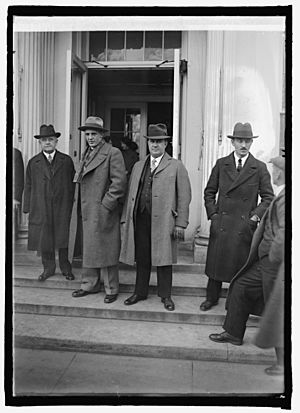
In Washington, the Bears met President Calvin Coolidge. When Grange was introduced, Coolidge joked, "Glad to meet you. I always did like animal acts."
The tough schedule led to many injuries. Grange hurt his left arm during the Giants game. The pain was so bad he couldn't return a punt in the next game. Fans and media criticized the game. Grange later wrote that he was booed for the first time. He realized that professional players are judged more harshly than college players.
Grange got hurt even worse in a game against a Pittsburgh all-star team. He tore a ligament and broke a blood vessel in his arm. The Bears had to cancel a game because of his injury. Grange missed another game because a blood clot formed in his arm. The Bears lost their last game of the December tour. In ten games, the Bears had 5 wins, 4 losses, and 1 tie.
January Tour
On December 21, the Bears went to Florida for more games. They took longer breaks between games to avoid more injuries. In their first game in Florida, Grange scored the only touchdown in a 7–0 win.
Before a game in Tampa, Grange was arrested for speeding. He paid the police officer $25. In the game, he scored on a 70-yard touchdown run. Grange and Pyle also invested in real estate in Florida. But hurricanes ended the land boom.
The Bears then played a team in Jacksonville. Grange threw a 30-yard touchdown pass in a 19–6 win. After a week of rest, they played in New Orleans. Grange ran for 136 yards and a touchdown.
Then, the team went to Los Angeles to play the Los Angeles Wildcats. About 65,000 people watched the game. The Bears won 17–7, and Grange scored a touchdown. They also won against a team in San Diego. In San Francisco, Grange was limited to 41 rushing yards in a loss.
In Portland, Grange and his teammate Earl Britton scored five touchdowns together. Grange threw a touchdown pass and ran for another. He left the game early after getting hurt in a pile-up. The next day, the Bears played the Seattle All-Stars. Grange scored two touchdowns and ran for 99 yards in a 34–0 win.
The Bears won 8 of 9 games on the January tour. After the Seattle game, Grange received his final payment of $50,000. In his first professional season, Grange made about $125,000.
Impact on Professional Football
Many people believe Red Grange's tours saved the NFL. They brought a lot of attention to professional football. Some critics say his injuries and performances weren't always great. But his fame definitely drew huge crowds.
In 1985, Grange said the tours were important for the NFL. But he also felt the league didn't do enough for older players who got hurt. He said, "I was sad for the oldtimers."
New York Yankees and the AFL
After the January tour, Pyle tried to buy a part of the Bears team. But the owners said no. So, Pyle and Grange decided to start their own team, the New York Yankees. They wanted to join the NFL. But the Giants owner, Tim Mara, felt the Yankees would take away his team's fans.
To challenge the NFL, Grange and Pyle started a new league. It was called the American Football League. It had nine teams. Grange played for the Yankees in this league. In 1926, the Yankees finished second.
The AFL closed after just one season. The Yankees team then joined the NFL. On October 17, 1927, the Yankees played the Bears. Grange got a serious knee injury in that game. He was trying to catch a pass when a Bears player hit him. His cleat got stuck, and his knee twisted. This injury affected Grange's speed and running for the rest of his career. He said, "After it happened, I was just another halfback."
Grange returned to play four weeks later to finish his contract. His injury got worse. After the season, he and the Yankees went on another tour. Grange explained that he kept playing because he thought he could get back to his old form. But the extra games made his knee even worse.
Later Playing Career
Grange's contract with Pyle ended in January 1928. Grange decided not to renew it because of his injury. He also left the Yankees team. Without Grange, the Yankees struggled and then closed down. Grange missed the entire 1928 season. He returned to the Bears in 1929.
Grange had two big moments in later championship games. In the 1932 championship, he caught the winning touchdown pass. In the 1933 championship, he made a tackle that saved the game for the Bears.
Red Grange was a very humble person. He said he couldn't explain how he played so well. He just followed his instincts. He stopped playing football in 1934. After that, he became the backfield coach for the Bears. The Bears' owner, George Halas, offered him the head coaching job. But Grange said no. He stayed as a backfield coach until 1937.
Acting Career
Pyle realized that Grange's fame could also attract movie fans. In 1926, Grange made his first movie, a silent film called One Minute to Play. Grange said making the movie was "the worst drudgery I'd ever experienced." The movie and Grange's acting received good reviews. One critic said, "If you've never seen Red Grange play football, now's your chance." The head of the film studio even asked Grange to quit football and become a full-time actor. But he said no.
The next year, he was in A Racing Romeo (1927). This movie was about car racing. Grange wanted to do his own racing stunts, but a professional stuntman was hired instead. This movie was not as successful. While recovering from his knee injury in 1928, Grange went on a nationwide stage tour called C'Mon Red.
Grange also starred in a 12-part movie series called The Galloping Ghost in 1931. He did his own stunts for this series. He said it was "The most strenuous work I have ever done in my life." As movies started to have sound, Grange found it hard to adapt to speaking roles.
Grange wrote in his autobiography that his acting career was a "memorable and worth-while" part of his life. He said it gave him confidence and poise.
Filmography
| Year | Title | Role | Notes |
|---|---|---|---|
| 1926 | One Minute to Play | Red Wade | |
| 1927 | A Racing Romeo | ||
| 1931 | The Galloping Ghost | 'Red' Grange | Serial, (final film role) |
Later Life and Legacy
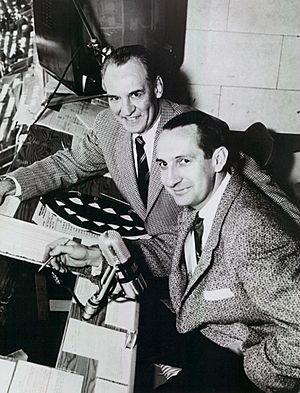
Red Grange left professional football in 1937. He then worked in different jobs. He was a motivational speaker and a sports announcer. In the 1950s, he announced Bears games for CBS television. He also announced college football games for NBC.
Grange married his wife, Margaret (nicknamed Muggs), in 1941. They were together until he passed away in 1991. Margaret was a flight attendant, and they met on a plane. They did not have any children.
In the 1940s, he worked as an insurance broker. In 1944, he was voted president of a new football league. But he left the position, and the league never played a game. Grange also led the National Girls Baseball League as its president from 1947 to 1949.
From 1951 to 1955, he served on the Board of Trustees for the University of Illinois. His autobiography, The Red Grange Story, was published in 1953. Red Grange developed Parkinson's disease in his last year. He passed away on January 28, 1991, in Lake Wales, Florida.
Honors and Tributes
In 1969, to celebrate 100 years of college football, the Football Writers Association of America chose an all-time All-America team. Red Grange was the only player chosen by everyone. In 1999, The Sporting News ranked him number 80 on their list of the 100 Greatest Football Players. In 2008, ESPN ranked Grange as the #1 college football player in history.
The University of Illinois built a 12-foot statue of Grange in 2009. This was to honor his achievements at the school. In 2011, the Big Ten Network named Grange number one in their "Big Ten Icons" series.
In 1931, Grange visited Abington Senior High School in Pennsylvania. Soon after, the school adopted his nickname, "the Galloping Ghost," for their mascot. Also, the football field at Wheaton Warrenville South High School is named Red Grange Field. The school's team is sometimes called the Wheaton Warrenville South Red Grange Tigers. The high school's track and field team also hosts the Red Grange Invitational event each year.
On January 15, 1978, at Super Bowl XII, Red Grange became the first person other than the referee to toss the coin at a Super Bowl.
Every December, a college bowl game is held in his honor. It is called the Red Grange Bowl and takes place in his home state of Illinois.
Images for kids
See also
 In Spanish: Red Grange para niños
In Spanish: Red Grange para niños
- List of unanimous college football All-Americans
- List of people on the cover of Time Magazine: 1920s


